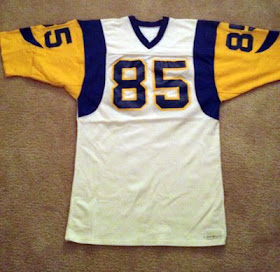By John Turney
We were thinking of doing a post on this very subject, but Pro Football Talk's Michael David Smith already nailed it in his recent post on the subject. You can read it HERE. We remember when Smith wrote THIS a few years back and appreciated it as well. Additionally, The Big Lead posted a story last year on the same subject and it was well done.
To Smith's post we would add the following:
While it is true Mamula was drafted higher than he would have been if he had not turned in a stunning combine performance, but he was likely going to be a first-round pick in the 1995 NFL Draft anyway, albeit a late first-round pick, if he had turned in a good, solid, but not spectacular, performance. At least that is my view.
The final draft pre-draft publications (post-combine) by two of the "draftniks
Insightfully Ourlad's
Mamula Mamula rushbackers
If he were to enter NFL today, he'd be like a Conner Barwin, Ryan Kerrigan, or a Terrell Suggs-type hybrid backer-end. As the NFL was in 1995, Mamula had a small chance of going to one of the few 3-4 teams left. Buchsbaum seems to have been pretty accurate in his projection.
As for the combine, yes, it was reported to bejaw Mamula
Smith details Mamula's career very well. We'd add in a 1995 nugget: five of his 5.5 sacks came against Jumbo Elliott (3 in two games) and Willie Roaf (2 in one game) showing he was not out of his depth in the NFL as a smaller, blind-side
The following season, 1996, Mamula had 8 sacks and 9.5 run stuffs, a good number for a total of 17.5 plays behind the line of scrimmage, three forced fumbles, three recovered, one for a touchdown—the numbers of a Pro Bowl-type season.
Also, we've posted his career stats, adding in run/pass stuffs and hurries. As the chart shows, Mamula was especially effective in 1996. In addition to the sacks and stuffs, Mamula, according to the coach's defensive statistics, led the Eagles in hurries in 1996, 1997, and 1999 and was tied for third in that category in 2000.
PFT's Smith rightly points out that injuries got the better of Mamula and forced an early career, not some kind of lack of talent or lack of production.
As for the combine, yes, it was reported to be
It was simply that he and his Boston College strength and conditioning coach Jerry Palmieri, who was recently let go by the New York Giants as their S&C Coach, knew what was to be expected and had his star athlete to
It can be argued successfully that Mamula was over-drafted, that he was not a talent that warranted being taken that high, but it really cannot be argued that he was not a mid-to-late-first round talent. Thus, if not performing like a seventh overall pick constitutes a "bust" in someone's mind, fine, but to call him one of the "Workout warrior All-time busts" is errant in my view. We have others, such as Vernon Gholston (zero career sacks, 2.5 career stuffs), for that.
It can be argued successfully that Mamula was over-drafted, that he was not a talent that warranted being taken that high, but it really cannot be argued that he was not a mid-to-late-first round talent. Thus, if not performing like a seventh overall pick constitutes a "bust" in someone's mind, fine, but to call him one of the "Workout warrior All-time busts" is errant in my view. We have others, such as Vernon Gholston (zero career sacks, 2.5 career stuffs), for that.
 |
| 2008 Combine results for defensive ends |
































































